

النبات

مواضيع عامة في علم النبات

الجذور - السيقان - الأوراق

النباتات الوعائية واللاوعائية

البذور (مغطاة البذور - عاريات البذور)

الطحالب

النباتات الطبية


الحيوان

مواضيع عامة في علم الحيوان

علم التشريح

التنوع الإحيائي

البايلوجيا الخلوية


الأحياء المجهرية

البكتيريا

الفطريات

الطفيليات

الفايروسات


علم الأمراض

الاورام

الامراض الوراثية

الامراض المناعية

الامراض المدارية

اضطرابات الدورة الدموية

مواضيع عامة في علم الامراض

الحشرات


التقانة الإحيائية

مواضيع عامة في التقانة الإحيائية


التقنية الحيوية المكروبية

التقنية الحيوية والميكروبات

الفعاليات الحيوية

وراثة الاحياء المجهرية

تصنيف الاحياء المجهرية

الاحياء المجهرية في الطبيعة

أيض الاجهاد

التقنية الحيوية والبيئة

التقنية الحيوية والطب

التقنية الحيوية والزراعة

التقنية الحيوية والصناعة

التقنية الحيوية والطاقة

البحار والطحالب الصغيرة

عزل البروتين

هندسة الجينات


التقنية الحياتية النانوية

مفاهيم التقنية الحيوية النانوية

التراكيب النانوية والمجاهر المستخدمة في رؤيتها

تصنيع وتخليق المواد النانوية

تطبيقات التقنية النانوية والحيوية النانوية

الرقائق والمتحسسات الحيوية

المصفوفات المجهرية وحاسوب الدنا

اللقاحات

البيئة والتلوث


علم الأجنة

اعضاء التكاثر وتشكل الاعراس

الاخصاب

التشطر

العصيبة وتشكل الجسيدات

تشكل اللواحق الجنينية

تكون المعيدة وظهور الطبقات الجنينية

مقدمة لعلم الاجنة


الأحياء الجزيئي

مواضيع عامة في الاحياء الجزيئي


علم وظائف الأعضاء


الغدد

مواضيع عامة في الغدد

الغدد الصم و هرموناتها

الجسم تحت السريري

الغدة النخامية

الغدة الكظرية

الغدة التناسلية

الغدة الدرقية والجار الدرقية

الغدة البنكرياسية

الغدة الصنوبرية

مواضيع عامة في علم وظائف الاعضاء

الخلية الحيوانية

الجهاز العصبي

أعضاء الحس

الجهاز العضلي

السوائل الجسمية

الجهاز الدوري والليمف

الجهاز التنفسي

الجهاز الهضمي

الجهاز البولي


المضادات الميكروبية

مواضيع عامة في المضادات الميكروبية

مضادات البكتيريا

مضادات الفطريات

مضادات الطفيليات

مضادات الفايروسات

علم الخلية

الوراثة

الأحياء العامة

المناعة

التحليلات المرضية

الكيمياء الحيوية

مواضيع متنوعة أخرى

الانزيمات
The Structure of Populations
المؤلف:
AN INTRODUCTION TO PLANT BIOLOGY-1998
المصدر:
JAMES D. MAUSETH
الجزء والصفحة:
20-10-2016
2697
The Structure of Populations
Populations can be thought of as having many types of structure; their distribution through the habitat is an important one, as is the age structure of the individuals.
GEOGRAPHIC DISTRIBUTION
Boundaries of the Geographic Range. The ability of a plant species to spread throughout a geographic area is a result of its adaptations to the abiotic and biotic components of that area. Although most habitat components act on the plant simultaneously and most should be considered important, at any given time and locality, one factor alone determines the health of the plant. This factor, whatever it may be, is the limiting factor. As described for photosynthesis, at a medium level of carbon dioxide, increasing the amount of light causes an increase in photosynthesis, whereas increasing the concentration of carbon dioxide does not; light is the limiting factor. As light intensity is increased, however, a point is reached at which brighter light does not cause more rapid photosynthesis. Then, an increase in the level of carbon dioxide does result in greater photosynthesis, and carbon dioxide becomes the limiting factor.
The concept of limiting factors applies to all aspects of a plant's interaction with its habitat. In areas of high rainfall, more water probably does not result in better plant growth, but the plants that are growing in the shady part of that ecosystem might benefit from more light, whereas those that are growing in the sunny spots might grow faster if more nitrogen compounds were available in the soil. Still other plants might not respond to extra light or nitrogen but would benefit from decreased herbivory. If each plant received extra amounts of the factor that had been limiting it, its growth would increase until some other factor became limiting. If the shaded plant received extra light, its growth rate would increase to the point where nitrogen perhaps became limiting. If a plant is placed in an optimal environment and given adequate amounts of nutrients, light, water, and freedom from pathogens, growth and reproduction increase greatly, but not infinitely; at some point the plant's innate capacity becomes the limiting factor. Crops on irrigated farms with weed control and pesticides are an example (Fig. 1).
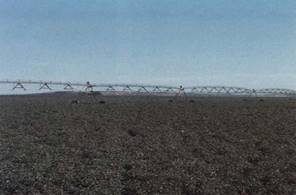
FIGURE 1: On modern American farms, plants are given optimal amounts of fertilizer and water, pesticides and insecticides keep pathogens under control, and a variety of weed-control measures eliminate competition from other species. If the seeds are not planted too close together, each plant has adequate room and grows as rapidly as possible. It is limited only by its own innate capacity for growth. (Courtesy of G. P. Mauseth)
Any factor of the ecosystem can act as a limiting factor. Water is important to many species; most cannot live in desert regions because of lack of water and most cannot live in marshes because of excess water. Extreme temperature inhibits plant growth in many regions; even if given adequate water, some plants cannot conduct it as rapidly as it would be transpired at high temperatures. For other species, high temperatures apparently cause enzyme systems to lose synchronization, and metabolism does not function correctly. Lack of warmth in winter is a limiting factor that keeps many species restricted to the tropics; temperate rain forests have adequate moisture and even richer soil than do the natural habitats of most tropical species, but the temperate rain forest habitat has freezing winter temperatures.
Biotic factors are also critical; many desert plants grow much more rapidly if given more water than occurs in their habitat, but their ranges do not extend into moist regions. Another important consideration is that plant species that rely on animals for pollination or seed dispersal cannot reproduce where their animal partners do not exist; the geographic range of these plants may be set by the limiting factors of the animals.
Soil factors often produce abrupt boundaries for the geographic ranges of populations. Both mineral composition and soil texture are important (Fig. 2). Soils derived from limestone, sandstone, or serpentine often have characteristic species growing on them. Beaches with loose, porous, sandy soils have species distinct from those on nearby soils that are more compact and contain more humus. The limiting factor for a particular species may be the same factor over its entire geographic range, but often it varies from area to area.
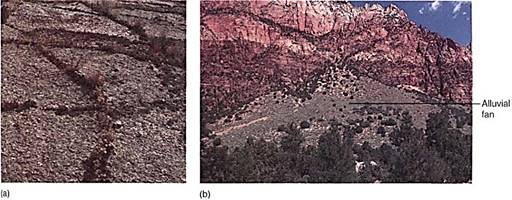
FIGURE 2: (a) The distribution of these plants is easy to understand. Most of this granite outcrop is so smooth that all seeds are washed off by rain—nothing can grow on it. But where it has cracked, soil accumulates, seeds germinate, and plants thrive. The plant distribution is controlled by the physics of crystallization and fracturing of large masses of granite. (b) Soil that washes out of valleys accumulates as a dry delta called an alluvial fan. The soil is open and porous and usually has its own types of plants, distinct from those in the hills or in the valley. (Bertram G. Murray, Jr./ Earth Scenes)
Local Geographic Distribution. In addition to large-scale geographic distribution of the entire population, small-scale, local distribution of individuals with respect to each other is also important. Individuals have one of three types of local distribution: random, clumped, or uniform. The term random distribution is used whenever there is no obvious, identifiable pattern to the position of individuals (Fig. 3a). A random pattern is one that has no predictive value; knowing the position of one plant does not let you estimate the position of another plant. In most habitats, many individuals seem to be distributed at random, but that may simply be due to the presence of many small-scale patterns that are difficult to detect or one large pattern that is too complex to see.
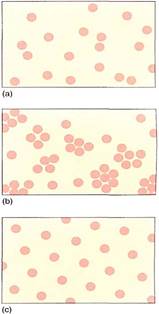
FIGURE 3: Types of distribution on a small scale. (a) This appears to be a random distribution, but examination of a larger area might have revealed a pattern. (b) Clumped distribution. (c) Uniform distribution.
Clumped distributions are those in which the spacing between plants is either small or large, but rarely average (Fig. 3b). This can result from many factors. The seeds of a plant often fall near the plant, not at uniform or random distances from it. If a bird or other animal eats many fruits and seeds, it will probably "deposit" them all together in a nice neat lump.
Uniform distributions are the types that occur in orchards and tree plantations; all individuals are evenly spaced from their neighbors (Fig. 3c). In natural populations, uniform distributions are not extremely common; those that do occur are thought to result from intraspecies competition. The roots of one individual may establish a zone that prevents the germination or growth of others. Zones can also be established, at least theoretically, by the release from the plant of chemicals that inhibit other plants. Such chemicals are called allelochemics and the inhibition is allelopathy. One example may be the purple salvias of California (Salvia leucophylla); they grow in a relatively uniform spacing with a zone of bare soil surrounding each shrub (Fig. 4). Several chemicals, particularly terpenes, are given off from these plants and have been shown to inhibit growth of plants in the laboratory; it is known also that these do accumulate in the soil near Salvia. It is not certain that these actually are allelochemics, however, because some experiments have shown that rabbits, mice, and birds that live in the salvia shrubs are mostly responsible £r the bare patches; if a wire cage is placed over a bare patch to exclude animals, plants do grow there. Presumably the bare patches are narrow because it is risky for the animals to venture too far from the cover of the salvia. It may be possible that terpenes are allelochemics under certain circumstances but that typically, animal herbivory prevents other plants from growing near salvia.
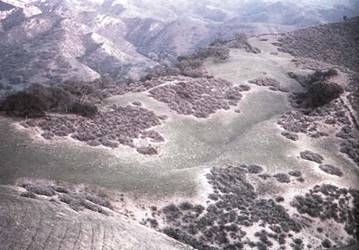
FIGURE 4: Each bush of Salvia leucophylla is surrounded by a zone devoid of vegetation. Allelochemics given off by the salvias penetrate the top layers of soil and inhibit seed germination. If a seedling can get its root through the top zone, the plant may grow well, but herbivory by rabbits and mice that live in the protection of the salvias then becomes a problem. (Roger Del Moral, University of Washington)
AGE DISTRIBUTION: DEMOGRAPHY
The manner in which a population responds to various factors in its habitat is affected partly by its age distribution, its demography—the relative proportions of young, mid-dle-aged, and old individuals. Analysis of age distribution has been applied mostly to animal populations and may be difficult to apply to plants, but the fundamental aspects are important and easy to understand. Imagine a species in which a pair of individuals produces four offspring by the time they die; the four offspring also double their numbers, so there are eight after they die. Future generations would contain 16, 32, 64, 128 individuals, and so on. This population is undergoing an exponential rate of increase (Fig. 5a), and there are always greater numbers of young individuals than old ones. This is important in determining whether most members are very young and highly susceptible; moderately young and vigorous; older and well-established; or very old and senescent.

FIGURE 5 : (a) Curve representing the number of individuals in a population that is growing exponentially. For this to occur indefinitely, growth must be controlled only by the organism's innate capacity for growth and the number of individuals present. In real situations, habitat limitations cause growth to be somewhat slower than the theoretical maximum. (b) Graph showing the more realistic situation in which the carrying capacity, K, is included. Instead of increasing infinitely (black curve), the growth rate (purple curve) decreases as the population size approaches the carrying capacity of the habitat. When population size equals carrying capacity, population increase stops; the death rate equals the birth (germination) rate.
Two factors affect the possible rate of population growth: generation time and intrinsic rate of natural increase. Generation time, the length of time from the birth of one individual until the birth of its first offspring, affects the rapidity of population growth: Annuals have a generation time of 1 year or less and can increase rapidly, whereas most conifers and angiosperm trees must be several years old before they produce their first seeds. For easier comparisons, we often measure population increase in terms of generations, not years.
The second factor, intrinsic rate of natural increase or biotic potential, is the number of offspring produced by an individual that actually live long enough to reproduce under ideal conditions. Even with optimal conditions, a large percentage of seeds do not germinate and many seedlings die before they are old enough to reproduce, so the biotic potential does not equal the number of seeds produced. For many species, biotic potential is a large number, represented in population equations as r. Plants that produce a large number of healthy, viable seeds over their lifetimes have a large r, a large biotic potential, and their populations can potentially increase greatly each generation. A species that produces fewer seeds than another species can reproduce faster than the second if it has a very short generation time, however. Mustard plants are small, live for only 1 year, and produce just a few seeds each, whereas oaks are large trees, each of which produces thousands of seeds in its lifetime. But a mustard population can grow more rapidly than can an oak population.
The biotic potential is measured under ideal conditions, but such conditions do not often occur in nature. Furthermore, once they do occur, even in a laboratory experiment, the very existence of the plants finally disrupts those ideal conditions. Once the population becomes large, the plants must compete for water, nutrients, and space. The number of individuals in each population that can live in a particular ecosystem is limited; that number is the carrying capacity and it is symbolized by K Theoretically, a population increases until the number of its individuals (N) becomes close to K; at that time, crowding and completion result in poorer growth, lower reproduction, and decreased chances that seedlings will be in suitable sites (Fig. 5b). Birth rate (germination) decreases and death rate increases. These factors continue as the number of individuals continues to approach K; when N and K are equal, population growth stops because death rate equals birth rate.
Many factors cause death rate to increase and birth rate to decrease as population size approaches carrying capacity (N approaches K). A large, densely crowded population is an ideal target for herbivores; most of the progeny of one pair of insects are likely to find suitable plants wherever they go in a dense plant population, so most survive. The large plant population is ideal for the insects, so the insects' population growth rate can increase toward their own biotic potential. The same is true of pathogenic fungi and bacteria. Even without considering predators or pathogens, large populations of plants may alter the environment physically, making it less ideal, as mentioned for the shading of pine seedlings by mature pine trees. A habitat filled with herbivores or pathogens or shade has a lower carrying capacity than the original habitat had.
On the basis of theory alone, we would expect that once a species invades a new habitat, it would undergo exponential growth as in Figure 5b, first increasing rapidly, later more slowly, and finally remaining stable with numbers that neither increase nor decrease. In reality, many factors prevent real populations from acting like ideal ones. As the population approaches K, it may not slow sufficiently and may overshoot the carrying capacity; there would be too many individuals temporarily, followed by a die-off that drops the number far below the carrying capacity (Fig. 6). With other species, as N approaches K, an explosive increase in the populations of many types of pests may occur, and the numbers of aphids, mites, caterpillars, and fungi may increase. The plant's pests have overshot their own K and they kill so many plants that the plant population falls far below its K, perhaps almost to zero. From there, it may then increase again, undergoing major cycles. Alternatively, as with pines, as the population increases, they change the environment to one that favors other species; their own reproduction falls to zero and as the adults die, the entire population is lost.
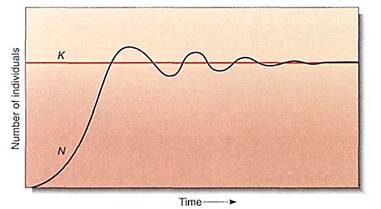
FIGURE 6: If a population increases slowly toward the carrying capacity of its environment, it may slow at K, as shown in Figure 26.23b. But often growth is too rapid and a large number of extra individuals temporarily survive; they then die off because of limited resources and the population falls below the carrying capacity.
r- AND K-SELECTION
As a population increases, theoretically it goes through a young phase in which numbers of individuals are low and resources are plentiful. Population growth is limited by the species' own biotic potential, r. Later, conditions are crowded, resources are more scarce, and population growth is governed by the carrying capacity of the ecosystem, K The lifetime of any single individual is typically much shorter than the time required for a population to pass through this full development. Therefore, which is more advantageous to the spades^ to become adapted to r conditions or to K conditions? The two are very different and require distinct, often mutually exclusive adaptations.
r-Selection. A disturbance usually produces r conditions. A fire or flood destroys many individuals in the area, and resources are plentiful for the few that remain, whether they are seeds, survivors, or immigrants carried in by wind, animals, or the flood itself. Pioneers that produce many seeds quickly have an advantage in that most seeds find suitable sites; if
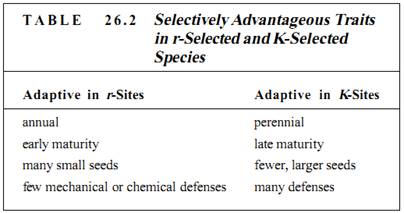
Seeds form too slowly, the sites may be filled by seeds of other invaders (Fig. 6). Because population density is low, the spread of predators and pathogens is slow, so the threat from them is not great; having antiherbivore and antifungal defenses is not so important because neither of those two agents is the limiting factor. Actually, the biotic potential is the limiting factor, so mutations that increase r are selectively advantageous (Table 26.2). Plants grow quickly, have few defensive compounds or structures, flower quickly, and produce many small seeds. Because most disturbances are impossible to predict and are widely scattered, seeds also must be adapted for widespread dispersal. r-Selected species typically are annuals or small shrubby perennials because the disturbed habitat gradually changes back into a crowded one that is no longer suitable for the pioneer r species. As more species of plants, animals, and fungi re-establish themselves in the area, the r-selected species are at a disadvantage; they have few defenses against predators and are too short to compete for sunlight. Only another disturbance can save them at this site; usually their population numbers fall to zero or close to it. The species itself survives because many seeds have emigrated to other sites, at least a few of which are appropriately disturbed areas (Fig. 7).
Some types of disturbances are predictable: killing temperatures in temperate winters and lethal hot/dry conditions in desert summers. r-Selected species are ideally suited for these environments. In spring, the habitat becomes suitable and may be almost devoid of plants. Small annuals grow and reproduce quickly, and population. Growth is extremely rapid until the habitat becomes disturbed by winter or summer climate.
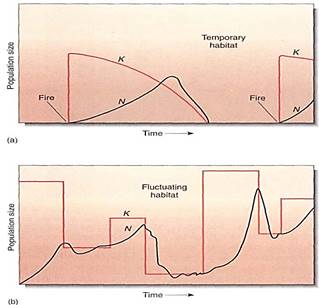
FIGURE6: (a) Most habitats have no carrying capacity (K = 0) for species that are not a natural component of the habitat's ecosystem. But a disturbance such as a fire, flood, landslide, or disease outbreak may alter the habitat, suddenly making it suitable for new species. A good example is a construction site: Where new roads and shopping malls are to be built, the clearing of the site suddenly increases the carrying capacity for many weeds. They had not been present before or were present in very low numbers because they compete poorly with the normal vegetation present before construction. The carrying capacity for the weed species soon begins to fall as other plants invade and the natural vegetation returns to areas not covered with asphalt. (b) A site's carrying capacity may vary less drastically as the populations of competitors, pests, and pathogens rise and fall in their own cycles. If most of the herbivores are suddenly killed by a bacterial disease outbreak, the carrying capacity for the plants suddenly increases. This lasts only until new herbivores move in or some other pest responds to the increased number of uneaten plants.
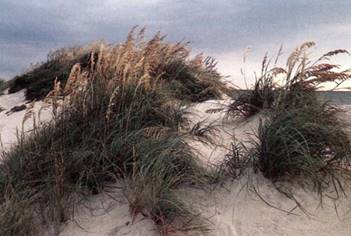
FIGURE 7: Most plants of disturbed habitats, such as these coastal dune plants, are /--selected species: Their wind-blown seeds land, germinate and grow quickly, and then produce many more seeds. They can grow so rapidly and reproduce so abundantly because almost no energy or mineral resources are spent on antiherbivore defenses or drought adaptations. Because of periodic storms, freshly exposed, highly disturbed sand dunes are always ready for invasion. Cape Lookout National Seashore. (C. C. Lockwood/Earth Scenes)
K-Selection. Conditions in a crowded habitat, where a population is close to its carrying capacity, select for phenotypes very different from those that are beneficial in a disturbed habitat (Fig. 8; Table 26.2). In a disturbed region, virtually every spot is a suitable site for seed germination and growth, but in a K habitat, almost every possible site is filled. Once an individual dies, its site may become occupied by the seeds or rhizomes of a different species. It is advantageous to live for a long time, holding on to a site. To survive as a long-lived perennial is difficult, however, and large amounts of carbon and energy must be diverted into antipredator defenses. These resources are then not available for growth or reproduction, both of which are much slower than in an r-selected species. Many long- lived conifers such as redwoods, douglas firs, and bristle-cone pines are good examples of A-selected species. A-Selected species also face intense competition from other plant species, and therefore adaptations that increase the ability to use scarce resources are beneficial. Examples of such adaptation may be the capacity to use low amounts of light or soil strata that are poor in nutrients.
Species that are r-selected can occur next to ones that are A-selected. Avalanches in dense forests open up small sites suitable for r-selected species. The same is true for hurricanes, fires, and floods. The floor of a deciduous forest is temporarily an r site during springtime, between the time when temperatures become warm enough for germination and growth and the time when the canopy trees put out their new leaves. For several weeks, the forest floor is sunny, warm, rich in nutrients, and temporarily uncrowned. Small r-selected plants that grow and reproduce quickly can complete their life cycles before the larger trees come out of dormancy and block the sunlight.
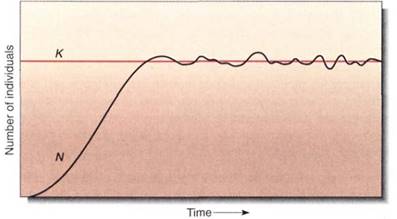
FIGURE 8: In a stable environment with stable climate and an ecosystem that has few disturbances, the carrying capacity does not fluctuate as it does in Figure 6. Under such conditions, competition and lack of sites may be the dominant limitations on population increase.
 الاكثر قراءة في مواضيع عامة في علم النبات
الاكثر قراءة في مواضيع عامة في علم النبات
 اخر الاخبار
اخر الاخبار
اخبار العتبة العباسية المقدسة

الآخبار الصحية















 قسم الشؤون الفكرية يصدر كتاباً يوثق تاريخ السدانة في العتبة العباسية المقدسة
قسم الشؤون الفكرية يصدر كتاباً يوثق تاريخ السدانة في العتبة العباسية المقدسة "المهمة".. إصدار قصصي يوثّق القصص الفائزة في مسابقة فتوى الدفاع المقدسة للقصة القصيرة
"المهمة".. إصدار قصصي يوثّق القصص الفائزة في مسابقة فتوى الدفاع المقدسة للقصة القصيرة (نوافذ).. إصدار أدبي يوثق القصص الفائزة في مسابقة الإمام العسكري (عليه السلام)
(نوافذ).. إصدار أدبي يوثق القصص الفائزة في مسابقة الإمام العسكري (عليه السلام)


















